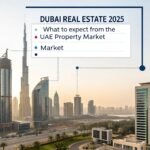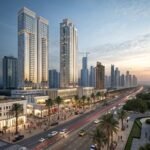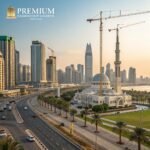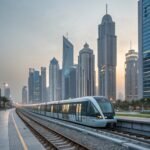Are you wondering what the future holds for property investments in the United Arab Emirates?
The market’s been shifting – trends are changing, and predictions can be tricky. It’s easy to get lost in the noise and uncertainty.
But understanding where things stand is crucial for anyone considering buying, selling, or investing in real estate across the nation.
This will give you a clear picture of what’s coming – potential growth areas, shifts in demand, and key factors shaping the landscape.
Let’s dive into the forecasts and explore how the UAE property market is poised to evolve by 2025 – giving you the knowledge you need to make informed decisions.
UAE Property: Shifting Sands
Thinking about simply buying property in the UAE based on recent headlines feels… outdated, doesn’t it?
A lot of forecasts right now are focusing on short-term price spikes – and frankly, that can be a risky game. It’s easy to get caught up in the excitement of potential gains, but ignoring the bigger trends could lead to serious problems down the line.
Instead of chasing fleeting booms, consider what’s actually built to last: strategic investments in areas poised for long-term growth and resilience.
The landscape is shifting – infrastructure projects are reshaping cities, population demographics are evolving, and government policies are driving significant changes across the nation.
Every decision made today impacts potential returns years from now; focusing solely on immediate gains could mean missing out on substantial opportunities.
But here’s what most analysts aren’t openly discussing: the future of UAE property isn’t about predicting peaks and troughs, it’s about understanding these underlying shifts and aligning investments accordingly.
Let’s dive into exactly how this ‘shifting sands’ scenario is shaping the forecast for 2025…
Macroeconomic Trends Shaping Demand
Yes, looking ahead to 2025 for the UAE property market, a lot hinges on how macroeconomic trends play out. It’s really about understanding what forces will be driving demand – or dampening it.
Economic Growth Remains Key. You see, continued growth within the broader economy is absolutely crucial. If GDP continues to expand, particularly in sectors like tourism and trade, that translates into increased wealth and confidence among potential buyers and investors. This naturally boosts demand for residential properties, especially luxury apartments and villas.
Specifically, a strong performance from key industries – such as logistics and finance – would provide a solid foundation. Furthermore, sustained foreign investment is vital; attracting further capital into the country will directly fuel property transactions.
Interest Rate Dynamics Are Critical. The level of interest rates on mortgages significantly impacts affordability. If rates remain relatively low, it encourages borrowing and makes purchasing more accessible, driving up demand. Conversely, rising rates could cool things down considerably.
It’s important to note that central bank policy – both within the UAE and globally – will heavily influence this. Any shifts in monetary policy are likely to have a ripple effect across the property sector.
Luxury Market Evolution – High-End
Many developments are focusing on creating exceptional luxury experiences. You’re likely seeing a shift towards bespoke amenities and unparalleled design features within high-end properties.
The demand for waterfront residences is predicted to remain exceptionally strong, particularly along the coastline. This isn’t just about having a view; it’s about access to exclusive marinas, private beaches, and a lifestyle associated with prestige.
We anticipate seeing more integrated developments that combine luxury villas with world-class yacht clubs and gourmet dining experiences – creating true hubs of social activity for affluent residents. The emphasis is on providing an all-encompassing experience rather than simply offering a beautiful space to live.
There’s also a growing preference for ultra-modern architecture, incorporating smart home technology and sustainable design elements. You’ll notice a move away from traditional opulent styles towards sleek, minimalist aesthetics with a focus on energy efficiency and cutting-edge innovation.
This isn’t just about luxury; it’s about demonstrating a commitment to future-proofing the property – ensuring its value and appeal for years to come.
Suburban Growth & Emerging Communities
It’s increasingly apparent that suburban growth is going to be a huge story for the UAE property market by 2025. Let’s really dig into what’s driving this shift and where you can expect to see the most significant developments – specifically focusing on emerging communities.
The trend towards larger, family-oriented homes is continuing, and demand in established suburban areas like Emirates Hills and Jumeirah Park isn’t showing any signs of slowing down. Developers are responding with more high-end offerings catering to this preference.
You’ll see a continued focus on amenities – large parks, schools, retail outlets – all designed to create self-contained communities where families can live and thrive. This is particularly important as the population continues to grow and people seek more space and a quieter lifestyle away from the hustle of Dubai’s city center. The key here is that these areas are already well connected by transport networks too which adds significant value.
But it’s not just about established suburbs; emerging communities are really taking off, particularly in regions like Al Marjan Island and Ras Al Khaimah.
These new developments offer a different appeal – often with more affordable options, modern designs, and a strong emphasis on waterfront living. You’re seeing master-planned communities that incorporate leisure facilities, retail spaces, and even educational institutions, creating vibrant hubs for families and young professionals. The development of these areas is also closely linked to ongoing infrastructure projects, further boosting their appeal and value.
Impact of Tourism & Investment Flows
As tourism continues its strong growth within the UAE, you can anticipate a significant boost across the property market. The influx of visitors brings increased demand for accommodation – hotels and apartments – but also fuels interest in residential properties, particularly those close to popular attractions and leisure areas.
The rise in tourist numbers directly impacts rental yields. Properties located near beaches, theme parks, or major shopping destinations become highly desirable, leading to higher rental income for landlords. This increased profitability encourages further investment in these prime locations.
For example, areas like Dubai Marina and Jumeirah Beach Residences are already experiencing elevated demand due to the influx of tourists seeking luxury waterfront living. Developments near Abu Dhabi’s cultural attractions – Louvre Abu Dhabi, Ferrari World – also stand to benefit from this trend, driving up property values in those neighborhoods.
Foreign investment flows, often linked to tourism development projects, are a key driver. Large-scale resorts and entertainment complexes attract substantial capital, which subsequently spurs demand for residential properties catering to the needs of expatriate staff and visitors.
You’ll likely see an increase in luxury villa developments near popular tourist hotspots. These projects often incorporate amenities like private pools and concierge services, appealing to high-net-worth individuals seeking premium living experiences linked to the thriving tourism sector.
Rental Market Dynamics & Vacancy Rates
With rising interest rates and a shift in economic conditions, understanding rental market dynamics and vacancy rates is crucial for anyone considering investing in property within the UAE. Currently, you’ll notice a complex picture – some areas are experiencing strong demand while others face increased availability.
The overall vacancy rate across major cities like Dubai and Abu Dhabi has seen a slight uptick recently, largely due to new supply entering the market alongside a moderation in population growth forecasts for 2025. This means there’s more space available compared to previous years.
Specifically, you’re seeing higher vacancy rates in newly developed communities where many apartments have been completed and are awaiting tenants. However, prime locations within established districts – particularly those with strong amenities and connectivity – continue to maintain relatively low vacancy levels due to sustained demand from expatriate workers and families. It’s a nuanced situation; your investment choices will depend heavily on the specific location you’re considering.
Government Policy & Regulatory Shifts
During shifts in government policy and regulatory changes, the UAE property market will likely see a period of adjustment. You’ll notice this most acutely when new rules are introduced regarding foreign investment or construction permits.
These adjustments can create uncertainty for developers who have planned large-scale projects based on previous regulations. This uncertainty can slow down construction timelines and potentially impact project costs.
For example, stricter environmental regulations could lead to delays in approving new developments, particularly those involving coastal areas or sensitive ecosystems. Similarly, changes to zoning laws might limit the types of properties that can be built in certain locations.
You’ll also observe a greater emphasis on sustainable building practices as government incentives and mandates shift towards eco-friendly construction methods. This could drive increased demand for green buildings and potentially elevate property values in areas prioritizing sustainability.
Essentially, the market will react to these policy changes – sometimes cautiously, sometimes rapidly – reflecting your confidence in the direction of future regulations. It’s a dynamic landscape that you need to be aware of as an investor or homeowner.
Sustainability’s Rising Influence – Green Spaces
Considering the broader forecast for the UAE property market in 2025, the influence of sustainability is becoming increasingly apparent. You’re likely to see a significant shift towards developments prioritizing green spaces.
Government initiatives are driving this change. There’s a clear commitment from authorities to promote environmentally conscious building practices and urban planning. This translates into regulations favouring projects incorporating sustainable materials and energy-efficient designs.
You can anticipate more developments featuring rooftop gardens, communal green areas, and water conservation systems – features designed to enhance the quality of life while minimizing environmental impact. The focus is on creating healthier and more attractive living environments.
Demand for properties with access to these green spaces is predicted to rise considerably. You’ll find that buyers are actively seeking out developments where they can connect with nature, reducing their carbon footprint and improving well-being. This trend will likely drive up property values in areas offering abundant green amenities.
Demographic Changes & Housing Needs
True, looking ahead to 2025 in the UAE property market, shifts within demographics are really going to shape what you need to consider.
A growing number of families are emerging. This means there’s a rising demand for larger properties – think three-bedroom homes and beyond – particularly in suburban areas that offer good schools and family-friendly amenities. You’ll notice more developments catering specifically to these needs, with features like bigger gardens and community facilities.
The rise of young professionals also plays a part. Many are choosing to rent for longer before committing to buying, preferring apartments in central locations close to workplaces and entertainment options. This creates a sustained demand for smaller units – studios and one-bedroom apartments – especially in areas like Dubai Marina and Downtown Dubai.
Furthermore, an increasing population of retirees is anticipated. These homeowners will likely be seeking properties with lower maintenance costs, often favouring villas in established communities with access to healthcare and leisure facilities.
This demographic shift means you’ll see a greater emphasis on ‘retirement living’ developments offering assisted care services and social activities – features that are increasingly important for this segment of the market.
Fractional Ownership & Co-Living Trends
Fractional ownership and co-living trends represent a significant shift in how people are approaching property investment and accommodation within the UAE. You’ll notice increasing interest as it offers more flexible options for those seeking lifestyle benefits alongside potential financial returns.
Fractional ownership allows you to own a portion of a luxury property – think villas or apartments – without the hefty price tag of full ownership. This is particularly appealing to younger generations and those new to the market who want to experience premium living without committing fully.
For example, you might purchase a share in a beachfront villa in Dubai Marina, gaining access to exclusive amenities and stunning views, while only holding a percentage of the property’s value. This offers a more accessible entry point into high-end real estate. Co-living spaces are also becoming increasingly popular, offering shared accommodation with private rooms – ideal for young professionals or those seeking community.
Risk Factors – Geopolitical & Economic
If you’re considering investing in property within the UAE right now, it’s absolutely crucial to understand the potential risks lurking beneath the surface. The forecast for 2025 hinges heavily on factors beyond just optimistic growth projections – specifically, geopolitical and economic shifts.
Geopolitical instability presents a significant challenge. Ongoing tensions in regional conflicts can directly impact investor confidence and, consequently, property values.
Increased uncertainty surrounding trade agreements, particularly those affecting major trading partners of the UAE, could dampen demand. Shifts in international relations always create ripples through global markets, and real estate is rarely immune to these tremors. A prolonged period of instability would naturally lead to a more cautious approach from buyers.
Economic headwinds are also playing a key role. Fluctuations in oil prices – a cornerstone of the UAE’s economy – could trigger broader economic slowdowns.
A decrease in oil revenue would inevitably impact government spending, potentially leading to reduced investment in infrastructure projects and impacting overall economic growth. Simultaneously, rising interest rates globally, regardless of local policy, can make borrowing more expensive for both developers and potential buyers, further cooling the market.
Long-Term Investment Outlook – Resilience?
Often, when looking at the UAE property market in 2025, you’ll hear about fluctuating prices. But a key question is whether this volatility represents a genuine threat or an opportunity for long-term investment resilience.
Considering global economic trends – and particularly how they might impact oil demand – it’s reasonable to anticipate continued shifts in investor sentiment. This could lead to periods of increased selling pressure, potentially pushing prices down further.
However, the UAE’s strategic location, strong economy (driven by diversification), and ongoing infrastructure projects offer a degree of stability that’s worth noting. These factors suggest a core level of demand will persist.
The rental market is also likely to remain robust, driven by population growth and high levels of tourism. This consistent income stream provides a buffer against potential price declines in the sales sector.
Therefore, while short-term fluctuations are expected, focusing on properties in prime locations with strong rental yields could represent a resilient long-term investment strategy. It’s about understanding that resilience isn’t necessarily about avoiding dips, but about positioning yourself to benefit from them.
Decoding Dubai’s Future: What’s Really Going to Happen in the UAE Property Market by 2025?
Smart investors aren’t simply reacting to market trends; they’re shaping them.
The forecasts paint a picture of continued, albeit measured, growth across key sectors within the UAE property landscape. Demand remains robust, fueled by population expansion and ongoing infrastructure development, particularly in areas surrounding Dubai and Abu Dhabi. While some segments – like luxury villas – might see adjustments as supply increases, strategic investments in sustainable developments and prime urban locations are poised to deliver strong returns. Analysts predict a shift towards mixed-use projects incorporating residential, retail, and leisure amenities, reflecting evolving lifestyle preferences. Furthermore, government initiatives supporting affordable housing and tourism will continue to bolster the market’s overall stability.
Understanding these dynamics allows for proactive decision-making. Delaying investment while waiting for definitive certainty risks missing crucial opportunities. Informed strategies – prioritizing locations with high growth potential and considering diverse property types – are key to capitalizing on this evolving landscape. Successfully Guiding the market requires a keen awareness of emerging trends and a willingness to adapt.
Don’t just observe; participate! Explore these forecasts, conduct thorough due diligence, and seize the chance to build a prosperous future within the UAE’s dynamic property sector. The time for informed action is now – shape your investment destiny today.






Leave a comment